
11 minute read
European wasp program success
2019–20 season wrap up
As the 2020–21 European wasp season gets underway, the Department of Primary Industries and Regional Development (DPIRD) is working towards localised eradication in the Perth’s foothills, thanks to an incredible reduction in nest numbers in 2019-20.
Advertisement

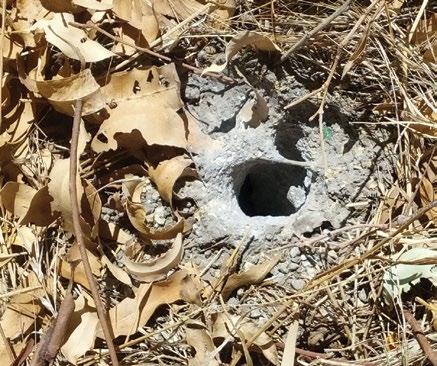
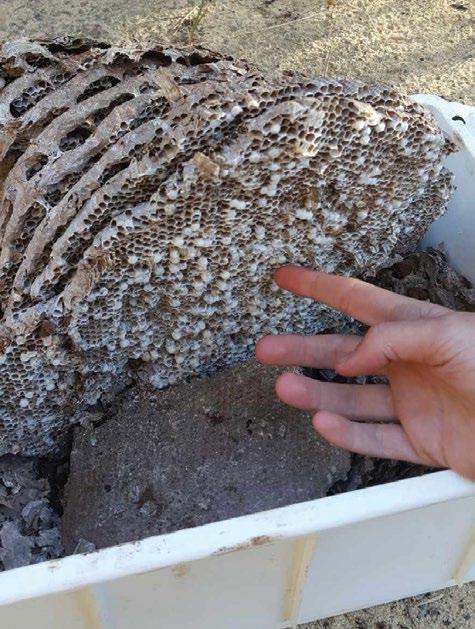
3 EUROPEAN wasps are a bright lemonyellow colour with black stripes and yellow legs, and their antennae are entirely black.
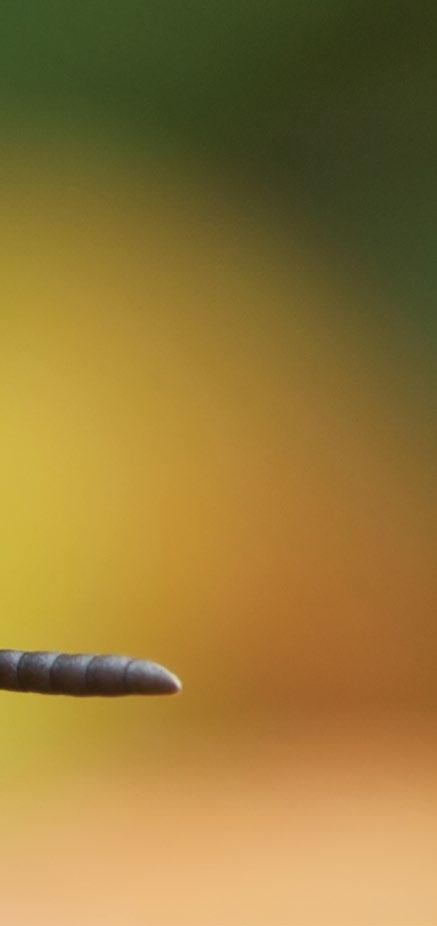
DPIRD invertebrate pests manager Mr van Schagen said the fight against this serious pest had been brought back from the brink, when nest numbers in 2018–19 were the highest seen in Western Australia for 15 years. The 43-year legacy of keeping European wasp from gaining a permanent foothold in WA continues. “The enormous amount of work that went into this program, and the commitment of additional staff and resources over the past two seasons has paid off, with nest numbers down 29 per cent — from 166 in 2018–19 to 118 in 2019–20,” he said. “Most notably, nest numbers plummeted across the Shire of Mundaring and City of Kalamunda — from 31 to 7 in Kalamunda, and in Mundaring from 25 to 0! “Additionally, we were able to find and kill 17 nests in 2720ha of continuous and challenging bushland in regional and national parks located in Orange Grove and Martin in the City of Gosnells. With zero wasp activity by the close of the season we hope to have seen the last of nests in this area.” Mr van Schagen said this was a mammoth effort given nests were located in almost inaccessible bushland areas. Although this success would not have been possible without assistance from the Shire of Mundaring, City of Kalamunda, Department of Biodiversity, Conservation and Attractions (DBCA) and Water Corporation to gain entry to bushland and navigate the difficult terrain. “The City of Kalamunda fire mitigation team in particular provided vital support, accessing and locating nests in some of the most inaccessible terrain,” he said. “With this collaboration and concentrated effort, we have been able to prevent wasps from moving deeper into the bush — which would have made it impossible to find them in the next season.” Trapping will continue across the Perth hills in 2020–21 to determine if localised eradication has been achieved, and whether the department can scale back its intensive surveillance in this area.
3 THE City of Kalamunda fire mitigation team.

Outside of the Perth hills, Mr van Schagen said trapping and surveillance by the City of Swan and Town of Bassendean also proved vital — detecting wasps alongside DPIRD trapping grids and preventing spread in these areas. Just as important were reports and trapping from other local governments, which confirmed the absence of wasps in their areas. “And of course, once again, community reporting of suspect sightings were significant and there were a number of community groups also trapping, and in some cases, hunted down nests from backyards to bushland alongside us,” Mr van Schagen said.
What’s next?
An important focus for 2020–21 will be the Swan Valley, due to four nests located and killed last season. Three nests were found close together in Middle Swan close to the river, and another nest was found further north east, on the western side of Toodyay Road. DPIRD is taking all efforts to ensure that if there are other nests in the area, they are found and killed to prevent establishment of new nests. This will involve the deployment of 134 traps in a 1km perimeter around the nest locations, in the areas of Lilac Hill, Caversham, Middle Swan and Herne Hill. They will be checked every two weeks. DPIRD will additionally target communications to businesses in the area to ensure winery operators and workers, visitors to the Swan Valley, and restaurants and patrons know how to recognise European wasp and make reports of suspect wasps. Mr van Schagen said European wasp have been known to damage horticultural crops like grapes and stone fruits, and a telltale characteristic is the attraction to human food and drinks. “In a way, this will make any wasps in the area easy to spot, as they are highly likely to make a beeline for eateries. Past season detections have included wasps flying into a lunchroom, landing on sandwiches and even in a grocery shopping bag! “As with all seasons in the past, public reporting is essential to finding and locating nests. This year we will have just under 3000 surveillance traps deployed in the metropolitan area, but the eagle eyes of the general public are just as important.” Reports help with the challenge of pinpointing the location of nests, which are hard to find because they are mostly hidden and underground. If there is a confirmed sighting of a European wasp, there is likely to be a nest close by.
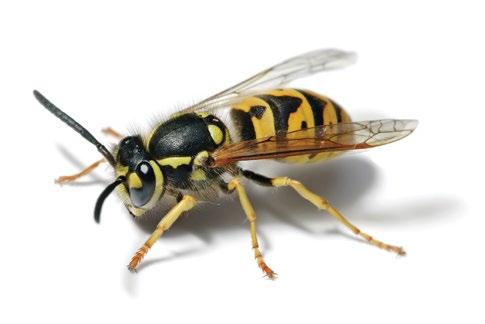
3 THE European wasp is considered to be one of the world’s worst wasp species.
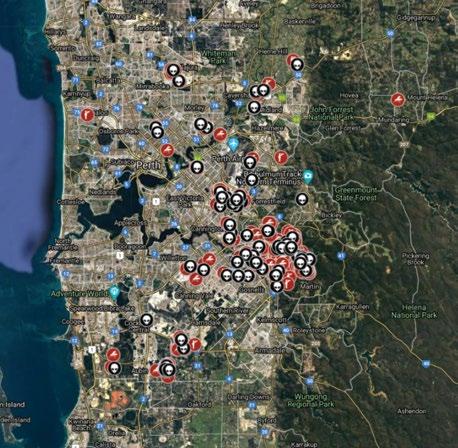
a
Mr van Schagen said every report counts. Even the most seemingly unimportant report has led to the location of nests. If you see something that makes you wonder, don’t second guess. Contact DPIRD immediately. “Based on last year’s detections we are also asking bushwalkers frequenting the areas of Banyowla Regional Park, Ellis Brook Valley Reserve, Korung National Park, the Victoria Reservoir and Canning River Regional Park to be alert and look for wasps,” he said. “Suburbs where we encourage people to be particularly vigilant include Malaga, Martin, Middle Swan, Kewdale, Belmont, Thornlie, Maddington, Welshpool, Kalamunda, Mundaring, Canning Vale, Gosnells, Orange Grove, Aubin Grove, Burswood and Banjup.” In regional areas, Hyden and Geraldton will also be trapped this season, due to detections last year.

b
3 A: European wasp nest distribution in the Perth Metro Area for the 2019–20 season. Black symbols show nest locations and red symbols show confirmed detections of European wasps. B: European wasp trap distribution in the Perth Metro Area for the 2019–20 season. Coloured icons indicate various European wasp trap locations.
What makes this wasp worse than the rest?
The European wasp is considered to be one of the world’s worst wasp species, most notably because it is scavenging and aggressive in its hunt for human food and drinks — even pet food. Should this pest become permanently established in WA, our outdoor lifestyle would be threatened. In the eastern states where European wasp is established, there are many stories of picnics or BBQs being invaded, and people being stung repeatedly after stepping on a hidden, underground nest. Their nests can grow to as big as a basketball, or larger, housing thousands of hungry wasps. European wasps are also an agricultural and environmental pest — they feed on soft fruits, rob beehives, and predate on bees, insects and small animals. Look — Act — Report
While European wasp looks similar to other insects, including the yellow paper wasp, it has distinctive characteristics that make it easily identifiable.

What to look for: • Wasps scavenging on human food, drink and on pet food; • Black feelers/antennae (similar looking to paper wasps, which have orange/yellow antennae); • Wasps flying in and out of a single hole in the ground (90% of nests are hidden underground); • Wasps flying with raised legs (all other wasps dangle their legs).
What to do: • Don’t attempt to destroy the nest if you find one — our staff will come and do that for you; • If you have European wasps in your yard, don’t eat outdoors, and that includes the pets; • Stay away from the nest if you know where it is. These wasps can be particularly aggressive if their nests are disturbed; • If you want to be more involved, you can start the investigation process by placing a piece of meat in a safe spot in your yard — fish is their preference. If they come for a feed, call DPIRD; • Once they have had a feed,
European wasps usually ‘beeline’ straight back to their nest, which is how DPIRD officers pinpoint nest locations.
How to report: Taking photos or submitting samples for identification is the quickest avenue for ID. Reporting options are listed below. Your report should include what you saw, where you saw it, and when it happened. MyPestGuide • MyPestGuideTM Reporter App
• mypestguide.agric.wa.gov.au
Pest and Disease Information Service • Phone: (08) 9368 3080 • Email: padis@dpird.wa.gov.au

Tigers New sea freight option for West Australian growers

THE LARGEST PERISHABLE freight forwarder in Western Australia, Tigers International Solutions (Tigers), has announced it will introduce a new cost saving way to ship fruit and vegetables overseas in the new year. Tigers is commencing a Less than Container Load (LCL) sea freight container service which will allow them to sell shipping space on a per cubic metre basis — a service that is currently unavailable in the WA. At present, growers wanting to export their produce by sea must fill an entire container, which can be difficult and expensive, especially for smaller exporters. Tigers general manager Jason Radford explained that an LCL container service will allow customers to use part of a container rather than having a full container. “We know that air freight prices can be too high for some export product lines, particularly with the impact of COVID-19 on air transport, so we’re looking at how we can put a shipment together as a consolidated sea freight container, which means more exporters can get their product to market,” Jason said. A recent report has identified the top four markets for Australia fresh vegetable exports as Singapore, The United Arab Emirates (UAE), Malaysia and Hong Kong. These markets have all seen an increase in trade value during 2020. Jason said the new LCL container service will initially target Singapore but will expand to other markets in the future. “Demand in Singapore has remained strong for Australian fresh vegetables and it is the only trading partner that has recorded a positive increase in both export value and volume during the COVID-19 period,” he said. “This is a great time to get your vegetables into Singapore, if you’ve been thinking of exporting.”
How much could you save?
According to Jason, air freight rates have historically been low enough that a grower could export a smaller loads when necessary, however the impact of COVID-19 on global air travel has seen air freight rates increase dramatically. Lines such as corn, or mescalin and baby spinach, with a shorter shelf life, will travel via air freight, whereas longer lasting products such as root vegetables, broccoli, leafy green vegetables, pumpkins, melons, apples and oranges, transport extremely well by sea freight. “Last year growers were paying about 80c/kg for 1000kg to be air freighted to Singapore, so they would be looking at $800 for the shipment,” Jason said. “Now with the increased cost of air freight due to the impact of COVID-19, 1000kg exported by air freight, is costing approximately $3000. “With our new LCL sea freight service we will soon be able to offer growers rates of about $300 per cubic metre, or per tonne, from Fremantle to Singapore, which will represent a significant saving.”
Getting started
• Find a market first. vegetablesWA,
AUSVEG and Austrade are great places to start when investigating how to get into various markets. Take some time to understand the market you’re sending to. A grower needs to be able to have a product that is suitable for the market and that will sell well for the customer Begin networking with overseas customers and get to know their businesses Once a grower has settled on a market, they then need to make sure their packaging is compliant with any Australian or overseas requirements. It must have the correct markings, such as ‘product of Australia’, the net weight, and identify what is being sent Sending a sample is also a useful exercise to ensure the customer is happy with that product and that it arrives in good condition Get registered with the Australian Department of Agriculture, Water and Environment as an exporter, which is a simple process involving an online application Research the market access requirements of the product/s being sent by looking at the https:// micor.agriculture.gov.au/ website. For example, into the Middle East, all food and vegetables need a phytosanitary certificate and need to be inspected by an authorised officer before it departs.
MORE INFORMATION
Tigers International Solutions: T: (08) 9479 0308 M: 0412 107 405










